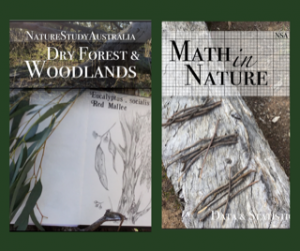Australian Dry Forest & Woodland Nature Study & Math in Nature: Data & Statistics
$22.99 $10.00
Let’s go walkabout in Eucalypt, Mallee, and Acacia biomes to investigate the ecosystems and ecological connections in the life of a gum tree.
We’ll climb with the koala to watch how she teaches joey to eat toxic eucalypt leaves (Yuk!), and dig complex burrow networks with a wombat. My! He can sleep! We’ll scavenge with elusive Quolls and hunt with Tasmanian Devils who crush skulls for dinner.
Then we’ll parachute from tree to tree with Gliders before prowling the forest floor with Lace Monitor who licks the air for scent molecules. Meet a dragon called Frilled-neck Lizard who ambushes his prey like the shy, secretive Carpet Python.
Become camouflaged and search for insects that mimick sticks and leaves. Sometimes, these insects can’t even find each other. Listen to the bush music as crickets and katydids play their violins while Kookaburra laughs, the owl barks, and Tawny Frogmouth calls ‘come, come, come,’ to see Bowerbird dance.
Watch as the woodland plantscape transforms each season from Summer’s grass show to Autumn’s fungi display. Winter brings carpets of moss and lichen’s perched on tree branches, but the greatest show is Spring’s wildflower celebration with orchids, lilies, pea flowers, native violets, and amusing trigger plants. Then step back and overview the challenges dry forest and woodlands face like bushfires and deforestation.
Discover the world of numbers by stepping back in time to clay cuneiform tablets that were used to collect data long ago. Then collect data through surveys, quizzes, or observation to create our own cuneiform tablet. Learn how to represent data through tally marks, Venn and Carroll diagrams. Types of numbers such as whole, natural, integers, rational, complex, odds, and evens among others are carefully explained.
Go fishing to explore mean, median and mode numbers, then collect and sort seeds and pods to make pictographs. Did you know line graphs can be used to create art? You’ll make your own line graph and turn it into an artistic masterpiece with a hidden message. Investigate pie graphs by brainstorming delicious pie types, then explore scattergrams and spreadsheets.
Every Math in Nature Guide has something to inspire the teacher. That’s you! 
Come along! Walk with us.
Dry Forest and Woodland Nature Study Guide Sample
PDF FORMAT
